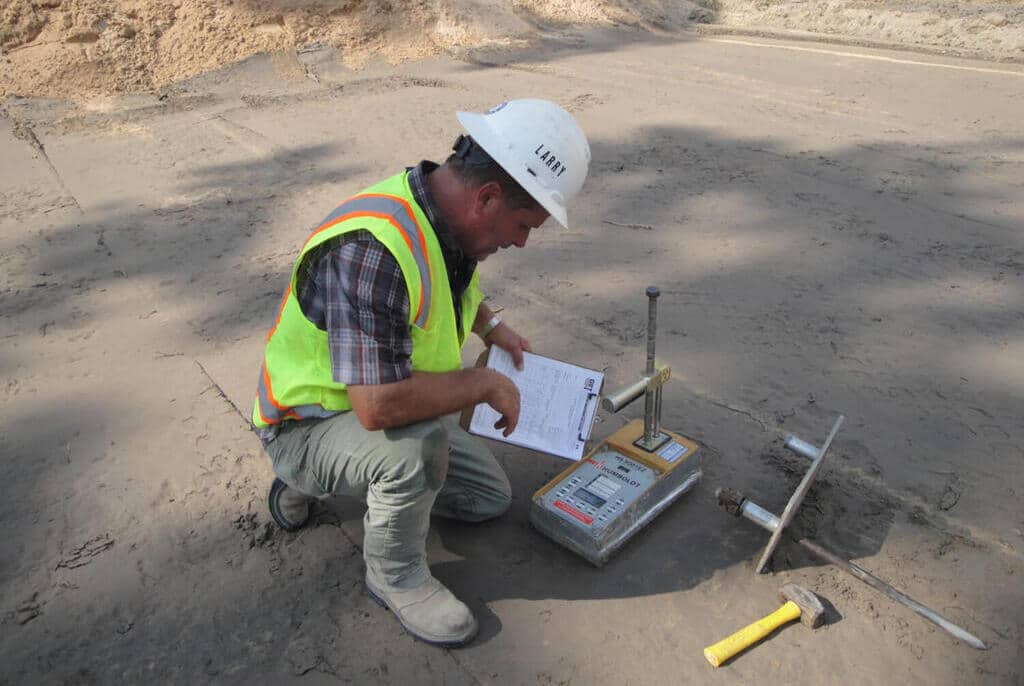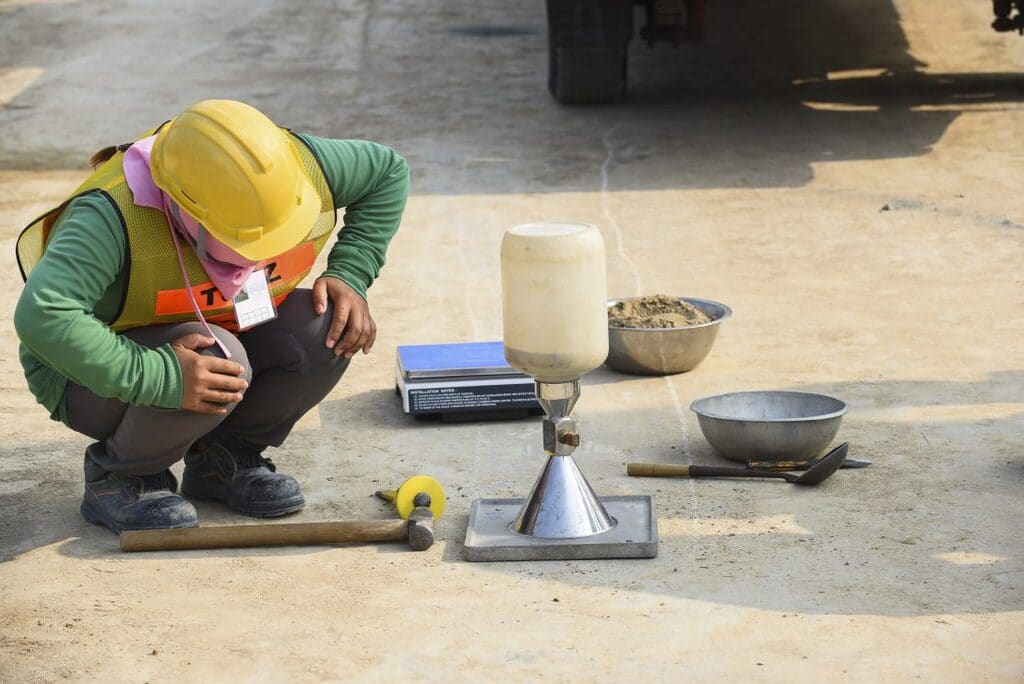There is much more than meets the eye when constructing a residential or commercial structure. Besides concrete walls and finished flooring, several hours of labor, safety precautions, and material quality must be considered. These are some of the most critical factors determining whether a structure will withstand the test of time.
What is Construction Material Testing (CMT)
The materials used to construct any structure, whether it is a road, a bridge, or a building, are critical to the project’s success. Similarly, you cannot bake a cake without the necessary ingredients. Likewise, you cannot construct a strong structure without using high-quality materials.
To put it another way, if the material used to construct a structure is substandard, the structure will not last long. The final product – whether it is a road, a bridge, or a building – will be only as good as the materials used to construct it.
Construction Materials Testing is critical when embarking on a project involving the construction of a new structure or the modification and improvement of an existing structure. This type of testing enables you to ascertain the materials’ quality, safety, efficacy, and durability.
On-Site (Field) Testing and Laboratory Testing
On-Site Testing:
On-site or field testing occurs on-site. This type of testing evaluates variables such as air, moisture content, and more using visual inspection or non-destructive techniques. The soil foundation, steel structure, and retaining walls are the three primary types of construction materials evaluated during field or on-site testing.
Laboratory Testing:
When exploratory or indeterminate field testing is required, samples of materials are taken and sent to a construction material testing lab for analysis and review. Additionally, if Field Testing indicates the need for additional study of materials, Lab Testing is the next step in the comprehensive CMT regime. This category of testing includes PH testing of soils, compression testing of any concrete, and so on.
Different Construction Materials That Need to Be Tested

Testing of Rocks:
The most frequently used building material is rock. Certain foundations are even constructed entirely of rocks. As a result, the stones used in construction must adhere to stringent quality standards. Three types of rocks are found: igneous, sedimentary, and metamorphic.
A civil engineer would conduct numerous tests to determine the type of rock and its electrical resistivity – a critical factor in preventing electric shocks. Additionally, durability and slaking tests are performed on rocks to ensure they will not disintegrate when exposed to moisture.
Testing of Bricks:
Bricks are referred to as load-bearing materials because they support your structure. The bricks used in construction must be strong and durable, as substandard bricks will disintegrate a structure within a few years, if not months.
A civil engineer must send a sample to a construction materials laboratory to ensure that low-quality bricks are not used in construction. It will assist in determining whether the bricks are sufficiently durable to withstand natural disasters.
Testing of Soil:
Soil testing in civil engineering entails an in-depth examination of the soil to determine whether it has a dry or moist base. Depending on the outcome, the engineer can decide whether to proceed with the construction or halt it.
Without soil testing, the foundation can deteriorate or sink completely, resulting in the collapse of the entire structure. Thus, the initial soil investigation reports must correspond to the laboratory-conducted subsurface soil examination.
Testing of Cement:
Cement is a critical component of construction, as it is one of the numerous materials used in large amounts. A few laboratory tests are conducted to ensure that the cement is strong enough to support the constructed structure.
A fineness test is used to determine the grain size of the cement on an individual basis, after which additional methods are used to ensure the cement is of high quality. Once the cement has been designated as durable, a consistency test is conducted to determine the amount of water required to transform it into a paste. These tests are cost-effective in terms of time, money, and effort.
Testing of Concrete:
Concrete is required for the construction of modern structures. A civil engineer performs numerous concrete tests to determine the quality of the concrete and its suitability for use. A slump test determines whether the concrete conforms to the mix design.
Another comprehensive test is performed to determine the concrete’s overall strength, which provides a clear picture of any potential cracks. The water permeability test is then used to determine the concrete’s durability.
Testing of Aggregates:
Pavement construction requires the use of aggregates. Aggregates have a significant impact on the load transfer capability of pavements, which is why it is critical to test them before application thoroughly. They are evaluated for their strength, toughness, hardness, absorption of water, and shape.
The Importance of CMT

Materials testing is carried out for various reasons and can yield a wealth of information about the materials, prototypes, or product samples being tested. Engineers, designers, and production managers, among others, can find the data collected during testing and the final test results extremely useful.
Regulatory Compliance:
Numerous products are used in hazardous environments where a failure could result in significant damage or injury. Several examples include manufactured fasteners and components critical for aircraft safety, bridges, vehicles, nuclear reactors, military equipment, and medical implants. Furthermore, numerous jurisdictions have enacted legislation limiting the use of hazardous materials.
In these instances, governments and regulatory bodies impose compliance requirements on manufacturers. To demonstrate compliance, businesses must adhere to these standards, which generally specify test procedures.
Material and Treatment Selection:
The quality of the raw materials used to manufacture a product is just as critical as the process’s reliability. Materials testing enables us to comprehend and quantify the suitability of a particular material or treatment for a specific application.
With such a wide variety of materials and treatments available on the market, testing can narrow the field of possibilities to the most suitable selection for the intended use. As previously stated, testing is performed on a wide variety of industrial applications to certify material to a given standard or specification or to ensure that it meets other stringent criteria before use.
Not only is testing frequently used to select materials and select a reliable supplier, but it is also frequently used as a verification process to ensure that material received from a new supplier is exactly what was ordered. Material testing may include procedures that provide information about a material’s structure or mechanical properties. Additionally, it may make sense to verify the material’s composition or elemental content using an instrumental or traditional wet chemical analysis technique.
Production Design and Improvement:
When a business specifies material for a new product design, it is common to purchase mechanical testing services. Mechanical properties such as strength, hardness, elasticity, and fracture toughness can be determined through testing. Corrosion testing can determine whether a material will remain stable under specified conditions, such as high humidity or exposure to saltwater.
When a more durable or corrosion-resistant metal is required for an application, it is frequently possible to achieve this through the addition of treatments. When necessary, heat treatment of the material before testing can ensure that the specified results are obtained.
Microanalysis can determine additional material characteristics by analyzing various surface features and detecting flaws and inconsistencies using microscopes and SEM equipment.
Production Processes:
Testing is an integral part of both the design and manufacturing processes, not just when safety is a concern but also for any business committed to selling reliable products and minimizing damage and costs if problems occur.
Testing is frequently conducted early in the product development process to evaluate a planned manufacturing process. It is also possible to provide ongoing validation for finished products. Numerous non-destructive testing techniques are used to assess completed products without causing damage to them.
Materials testing is also critical in failure analysis investigations because it enables the identification of defective products, insufficient materials, and, ultimately, the cause of a failure.
Materials testing is a regulatory requirement for most large-scale projects throughout the country and is considered a prudent investment. Complications resulting from incorrect material can result in financial losses, project delays, and, in some cases, more severe consequences such as infrastructure malfunction or collapse.
keep reading:

